Today’s consumers produce a digital footprint, whether it is posting reviews on social media or interacting directly with a brand online. They use multiple channels and have high expectations for their experience. They also use those channels to vent frustration, dissatisfaction, and scathing feedback in a viral environment. And when they want to buy something—anything, it seems—they appear to place as much trust in those online reviews by strangers as they do in recommendations and referrals from people they actually know.
The rise of social media as an outlet for consumers throws a wide, dark shadow on businesses that support only traditional communication methods. Today, consumers have the power with a single review to make or break a business through social platforms including Yelp, Facebook, and Google.
In working with home builders across the country, we find most aren’t paying much attention to their customer reviews, especially those on social media. The builders tend to be reactive, only responding when customers vocalize that something has gone wrong; that is, if they respond at all.
Some builders harbor a fear of customer feedback, especially when it comes to a potentially negative impact on their bottom line. Others are simply dismissive, blindly believing customer reviews are anomalies, that only dissatisfied customers speak up, and that these reviews aren’t truly representative of all their customers’ experiences. These are all dangerous attitudes.
Proactively listening to customers and shaping customer ratings into a tool can make your business smarter, more efficient, and more profitable. Let’s examine how you can improve four key business areas by actively mining and mastering customer feedback—both the good and the bad.
1. Invest in consumer insights
What is it worth to you, as a builder, to have a single data source that informs your design and land planning, construction, sales, and warranty service teams—effectively, your whole operation? Considering the time and money you spend on creating, delivering, selling, and servicing new homes, mining customer reviews is a great place to start getting a real feel for whether those investments are on the right track.
Customer reviews and feedback can inform direction and product innovation, shedding light on benefits of both your services and products. But if you aren’t paying attention or you lack the means to collect and internalize that feedback, how can you effectively design what customers want and sell it to them?
Here’s where it’s important to hire people who, unlike most of the people who lead your company, directly reflect your customers in terms of income, education, employment status, and social media activity. They will intuitively know what your target consumers want and how to reach them effectively.
You also should purchase and analyze consumer segment data to gain even deeper insight into your customers. Segmentation offers a statistically sound measure of consumer preferences and expectations for a new home that complements live and online anecdotal feedback.
2. Enhance the customer experience
Today’s new-home shoppers, especially younger Millennials, place a higher value on the buying experience or “journey.” They value relationships, people, and emotions—which is why they are so oriented toward, and critical of, the experience.
Take a few moments to search for Google reviews of your company, just like your customers do (how: type in your company name and the word “reviews” to see them).
Once you’ve identified customers’ critical issues and how they express them about your product and services, collaborate within and between your teams to create an action plan that addresses and alleviates those pain points.
It’s an agile process; one you should prepare to revisit if the results don’t have a positive effect or if the feedback changes. And, after successfully addressing one hot button, you can focus on another one or more, if you have the resources.
Regardless of how many issues you address at one time, this method will help you improve the entire customer experience and keep your whole organization involved and engaged.
3. Embrace negative reviews
Buying a home is a huge financial and emotional investment, and customers frequently make personal connections with the people helping them through the process. Homeowners who experience unexpected problems after moving into their new home may feel ignored or cheated by their once-trusted friend, and they often turn to social media to express those feelings.
Consumers don’t discriminate with their scorn, meaning all builders, regardless of volume or geographic footprint, are subject to negative reviews.
Reading customer reviews of your own company and those of other businesses will help you grasp the terms and phrases customers use to describe their buying experiences.
Negative reviews can turn into a huge, lasting positive if you respond to a comment promptly, sincerely, and constructively because it establishes and enhances your integrity and commitment to improve. You can cement customer loyalty and increase post-purchase satisfaction by being diligently aware of issues customers are experiencing, acknowledging their frustration, and taking steps to make it right.
4. Inform market segmentation
One of the foundations of great marketing is the knowledge that not all customers are the same. Digging into online reviews about your company unveils key behavioral and psychographic aspects, from how customers communicate and interact with your company to how they think about themselves and your product. Mining customer ratings for key terms and phrases and using them in your website and social media content has the potential to enhance your search engine optimization (SEO) efforts.
Simply put, the language consumers use to search and post on social media is the way they speak. Customer feedback can uncover key phrases to optimize paid search results and craft relevant, impactful social media posts for targeted market segments. In turn, traffic to your website will increase (boosting SEO), as will the number of eyes on your product.
Customer reviews are important in the digital age. Builders should be wary of creating a strategy that only seeks to boost the number of customer ratings instead of the quality of that feedback and the resources to mine, respond, and internalize it.
Some builders may need more help than others when it comes to formulating an effective strategy for managing customer reviews and feedback. Consultants that specialize in consumer insights are rare in the housing industry but are often the key to helping builders unlock greater success and customer satisfaction.
Ultimately, the bottom line is that builders can’t improve their products and services if they don’t act on customer feedback.
Sidney Pell is the manager, consumer and product insights at John Burns Real Estate Consulting, in La Jolla, Calif. Contact her at spell@realestateconsulting.com.













